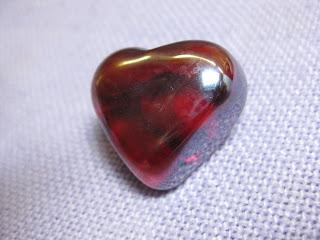 |
| Before: Glass bottle |
Today is Friday and project five of NJAD Valentine's Day week. We went back to our stash of bottles, broke a beer bottle into glass frit and fused it to create a nifty heart shaped pin. With so many, V-Day inspired jewelry, my daughter and I are going to have to negotiate who gets to wear what.
Have a great weekend.
 |
| After: Heart pin by GeltDesigns.com |
Glass bottle
1-inch pin finding
Etching cream
Rubber gloves
Tools
Eye goggles Dust mask
Kiln wash/ shelf primer
Glass fusing kiln
Welding goggles
Step 1
Clean the bottle.
 |
| Break bottle into frit |
Put on eye goggles and a dust mask to protect your eyes and lungs from glass dust and flying, broken shards of glass. Put the glass bottle into a plastic bag and wrap a towel around the bag to reduce the risk of flying shards of glass. Use a hammer to break the glass bottle into very small pieces. Warm glass artists call small pieces of broken glass frit.
We used a Carlsbad beer bottle. Carlsbad makes beer bottles in a really, really nice shade of green and the color withstands heat in the kiln.
 |
| Put frit in heart mold |
Place the glass frit into a heart shaped mold prepared with kiln wash.
Step 4
Place the mold into the kiln. I based my firing schedule on experience from fusing the pendant from a beer bottle on January 4. I used a small top loading kiln, so I could watch the glass closely and see when the glass melted. For this project, I raised the kiln to 1500 degrees F and held it for about six minutes.
Note: Always put your kiln on a fire safe work surface and wear protective eye goggles (such as those used for welding or lampwork) when looking into a hot kiln.
Step 5
Anneal the glass. Lower the kiln to the annealing temperature(about 960 degrees F) and hold the kiln at that temperature for 10 minutes to anneal the glass.
Step 6
Allow the glass to cool to room temperature. Remove the glass from the kiln and wash off any kiln wash on the glass.
Step 7
Etch the glass. Put on rubber gloves and etch the glass with etching cream.
We etched the glass to give it a mat finish so that the findings were not visible through the pin.
 |
| Glue on pin back |
Glue the pin back finding to the back of the etched, heart shaped glass.
Related Tutorials
How to Make a Pin Back
Make Glass & Copper Earrings
Make a Pendant from a Bottle
Turn a Glass Jar into a Pendant
Make a Glass & Knotted Leather Necklace
Make a Glass & Brass Link Bracelet
Make Recycled Glass & Sterling Silver Earrings
Make a Kiln Formed Bracelet
Make a Glass Charm Necklace
NJAD Index (Days 1 to 60) by Type of Jewelry
NJAD Index (Days 1 to 60) by Type of Found Object
Day 83. Month 4. Jewelry from Found Objects. $ spent to date: 0
Found materials: Carlsbad glass beer bottle
New Jewelry a Day.



















